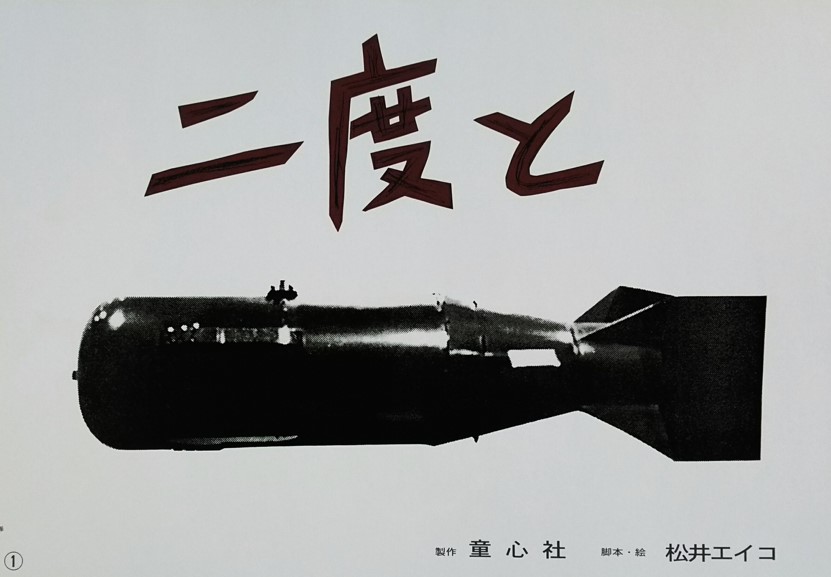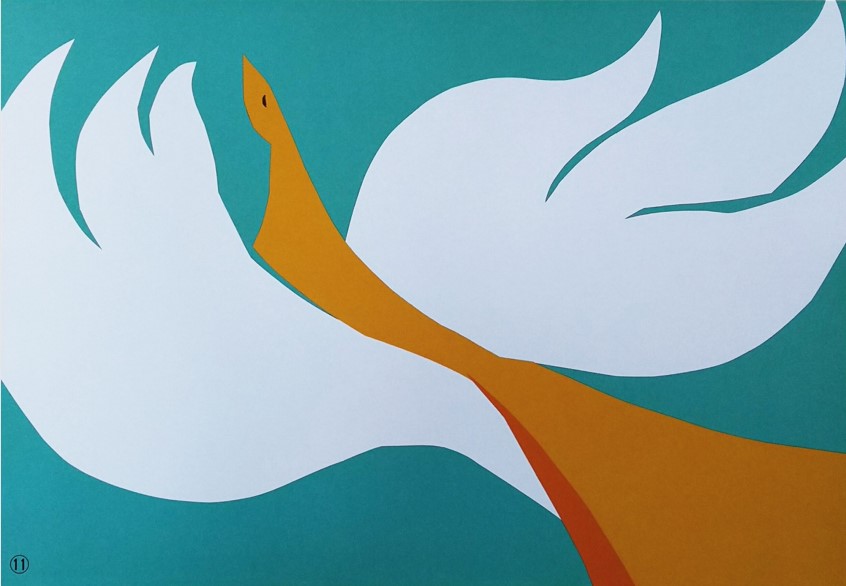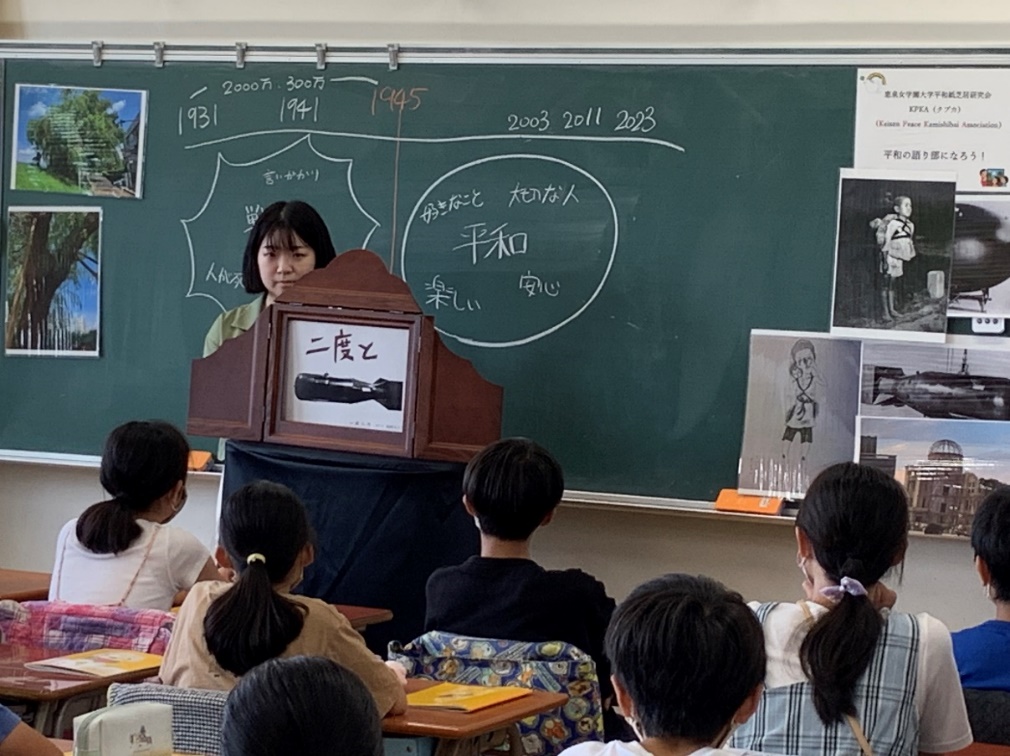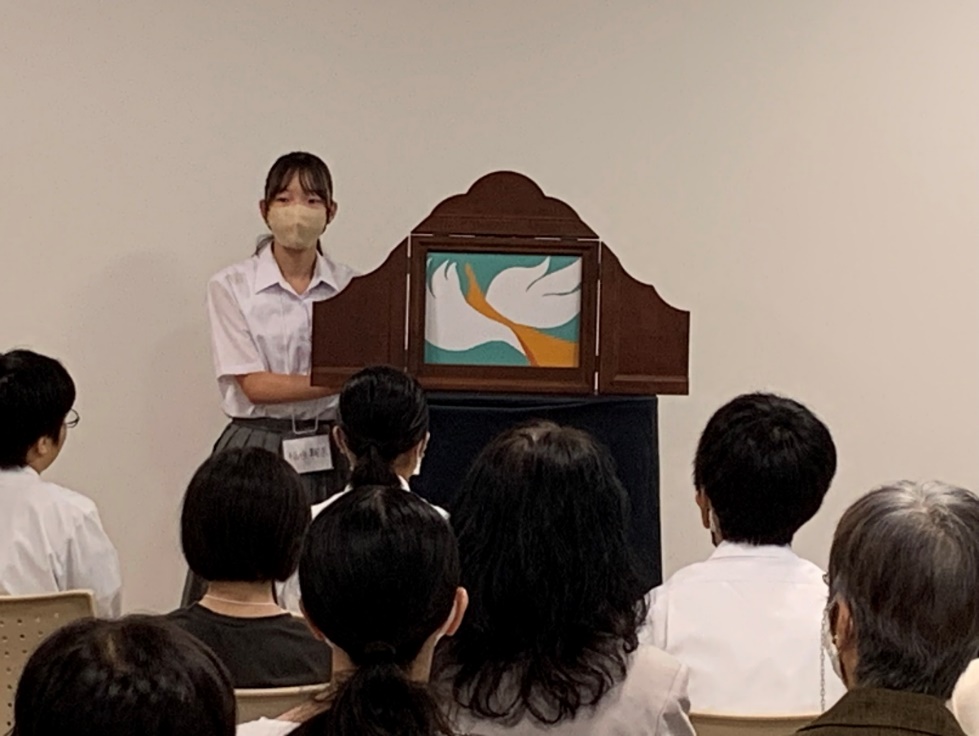32nd JAMCO Online International Symposium
February 2020 - March 2020
Messages for an Increasingly Divided World
Nido To (Never Again) - A Kamishibai Play to Nurture Storytellers for Peace
Russia began its invasion of Ukraine in February 2022. In December of that year, a group of students at Keisen University in Tama City in the outskirts of Tokyo began visiting local primary and junior secondary school children to educate them about the importance of peace. The students are members of the Keisen Peace Kamishibai Association (KPKA: pronounced “Kupka”), and the idea was to become storytellers for peace. They rely on kamishibai, a form of storytelling using a series of illustrations. The group visited five schools in the seven-month period up to July 2023, performing in front of 15 classes (see Photograph 1).
There are two distinguishing features in the lessons about peace provided by KPKA. First, the group uses a kamishibai performance called Nido to (Never Again) (see Figure 1), written and illustrated by Eiko Matsui, which focuses on the atomic bombings of Hiroshima and Nagasaki. Second, the group also has the school children performing the story, giving them first-hand experience of kamishibai storytelling. In the first hour, the children watch the performance, while in the second, they became the performers. The children are divided into a number of groups with one of the children narrating the story in front of the others. In other words, there is a shift from “seeing to performing”.(1) At the end of the lesson, the children are asked to write about what they think they can do to build a peaceful future. Through these activities, KPKA wants to get the message across to children that they aren’t powerless, that they can do something no matter how small; they too are urged to become storytellers for peace. The purpose of the lessons is to encourage the children to become personally and directly involved in building peace.
The Keisen Peace Kamishibai Association was launched in February 2020 around the start of the Covid-19 pandemic. It looked like the group might not last, there was the question of whether it could actually get started with the halting of its activities and a drastic decline in membership. It held online workshops and online gatherings, and went to Hiroshima in August 2022 as part of a program organized by the Tama City authority that takes local children to the sites of the atomic bombings. In December of that year, the group began visiting schools to give lessons on the importance of peace using their kamishibai performance.
This paper will describe the format and distinguishing features of kamishibai, a performing art that developed in Japan, feature the ideas of the creator of Nido to (Never Again), the story that is the centerpiece of the lessons, and provide an account of the changes that Keisen students experienced from their encounter with this story and the lessons they have given to school children. Beyond that, it will describe the structure and key points of the lessons, and provide a summary of what the school children feel about the classes and from performing kamishibai, and about what action they feel they ought to take. In the final section, this paper will talk about where the Keisen Peace Kamishibai Association is looking to proceed at a time when societies risk being torn apart.
1.Kamishibai: Format and distinguishing features
Kamishibai literally means kami (paper) and shibai (stage play). It follows a different format and has different traits from the printed medium of picture books made up of illustrations and text. A picture book depicts a scene, which moves on with the turning of the page. Kamishibai, however, moves from one illustration to another, sliding them like the fusuma sliding doors and shōji sliding windows found in a traditional Japanese home. The storyteller inserts eight to twelve illustrations in a wooden frame that provides the “stage” as it were. Each illustration has text on the back which the performer narrates while showing the illustration to the audience. The illustration is then slid out horizontally from the frame and the next one inserted with the next set of text to continue the story. The performer is facing the audience while narrating the story, making the audience feel they are where the story is unfolding. Removing the illustration and then showing another, showing them one at a time, makes the audience concentrate more. A trait of kamishibai is the shared enjoyment between the performer and the audience or among the audience. Kamishibai has ancient roots. It appears in the Genji Monogatari Emaki or The Tale of Genji Scroll, an illustrated handscroll produced during the Heian period (794-1185) of the literary classic The Tale of Genji.
However, it appeared in its current form, where the performer inserts illustrations into a frame, around 1930.
2.Never Again and its impact on students
- 2-1.The story and how it is structured
Nido to (Never Again), the story used in the lessons by the students in the KPKA, was published by Doshinsha Publishing Co. in 2005, sixty years after the end of World War II. The following year it was selected to appear in the Hello, Dear Enemy!, the international exhibition of picture books on peace and tolerance organized by the Youth Library in Munich. Since then, it has been exhibited internationally, and translated and performed in English and other languages. In Never Again, there is outrage against war and nuclear weapons and a fervent desire for people. It has been acclaimed as an indispensable work for talking about peace.(2) Moreover, it can be described as an outstanding work of art, possessing both power and beauty, appealing to the inner soul of the performers and the audiences.
Never Again is made up of twelve scenes (illustrations). The first half uses black and white photographs to talk about the making of the atomic bombs, when they were dropped, the destructive force they unleased, and the devastation they caused to Hiroshima and Nagasaki. The second half, made up of pastel illustrations, gives actual accounts of what happened to buildings, trees, and an 8-year-old girl. It repeatedly says atomic bombs should never be used again, that there should be no more Hiroshimas or Nakagasakis. A white bird emerges amid such calls (see Figure 2). The story ends with the bird taking flight in a blue sky free of war.
The author Eiko Matsui describes the shared emotions, which are a distinguishing feature of kamishibai, and kamishibai works that are concerned with peace:
Kamishibai has a wonderful ability to evoke shared emotions. And when it comes to kamishibai stories concerned with peace, I believe that they should deal squarely with war, grasping its essential nature, and provide hope and aspire to being able to overcome it. They provide children with a sense of what it means to be human. Children who see Never Again tell me they would like a copy of it. I would like everyone to perform it. I would like kamishibai here and now to help bring about peace among those of us who have no firsthand experience of war.(3)
-
2-2.Changes among the students
A member of KPKA, whom we shall refer to as “Y-san”, said she felt intimidated by the weightiness of the subjects in Never Again and the horrors depicted in it until she took part in the visit to Hiroshima in 2022. She admits that she didn’t want to read it. Looking back, she says she read the work after visiting Hiroshima with the group of children from Tama City, and seeing the cenotaph to the bomb victims and a number of items that had belonged one of the victims, a girl in junior secondary school. Y-san said she couldn’t stop crying. At the same time, she said wanted to learn more about atomic bombings and war. She became involved in the performances of Never Again and gave a performance at the chapel at Keisen University on 7 December, which is World Kamishibai Day. Y-san began studying the history of the Pacific War, and the classes on peace brought back memories of street children she saw during a visit to the Philippines when she was a girl; she said in the future she would like to help children who are in hardship in Asia.
Here is the case of another member, whom we shall refer to as “M-san”. M-san says her introduction to Never Again and preparations for the lessons for the local school children brought back shocking memories of a visit to France as a high school student where she saw a concentration camp for Jews. When M-san rehearsed Never Again, she was unhappy with the way she was narrating the scene about the mushroom cloud that appeared after the atomic bomb was dropped, the scene that describes the great flash and the tremendous bang. She says she went over this part repeatedly. M-san worked on it by watching footage and learning more about the atomic bomb. However, she says she no longer had any doubts about how to express this part when memories came back of graffiti left by children at the concentration camp. Looking back, M-san said she faced up to herself and was able to give a genuine rendition when she felt for the souls of all those who have been victims to war. She is looking to pursue work relating to peace and human rights after her graduation.
Performing Never Again connects a person deeply with his or her inner self. The practical experience of giving lessons to local children and performances of this kamishibai work have prompted the students in KPKA to confront themselves and direct their attention to the world around them and seek out ways of living as global citizens.
None of the members of this group is seeking a career in teaching. The students are majoring in subjects such as gardening, human rights, Japanese culture, and English communication. The are ordinary students who have involved themselves with Never Again and the kamishibai stage and who are giving lessons about the importance of peace in the local primary and junior secondary schools, calling on children to become storytellers for peace.
These activities bore fruit on 5 August 2023, exactly a year from the trip to Hiroshima, in the shape of kamishibai performances at Tama City’s municipal library. They were part of the peace exhibition there. The performances were organized by the members of KPKA and people and children they had met during their trip to Hiroshima and in the classes they had given at local schools. Ten children ranging in age from elven to sixteen put on performances under the guidance of the students in KPKA (see Photograph 2). The children were from primary, junior secondary and senior secondary high schools. The kamishibai works gave accounts of war and conveyed the importance of peace. The audiences found them moving. The event was also reported in the newspapers and on television.
- 3-1.Storytellers for peace
The Keisen Peace Kamishibai Association was launched in February 2020 to take kamishibai performances to local children’s daycare centers and welfare facilities with a view to bringing smiles and building peace in the immediate community. Its aim was to practice Keisen Unviersity’s spirt of service, founded on love, peace, and life.
However, all of the workshops and performances the group had planned were cancelled a month later because of the spread of Covid-19, which prompted the authorities to restrict people’s movements and which led to the closure of the university. Activities on a face-to-face basis were only able to resume in late 2021, when the group was able to give Christmas performances at a local children’s daycare center and a facility for people with severe disabilities.
Russia’s invasion of Ukraine in February 2022 made learning about peace and war even more compelling for the members of KPKA. They got the opportunity to accompany a group of primary and junior secondary school children on a visit to Hiroshima from 6 August 2022. The trip, organized by the Tama City authority, visited war ruins in Hiroshima.
The members gained a keen awareness of the realities of war from what they learned and through the people they met during their three-day, two-night visit to Hiroshima. They held a gathering to tell others about the trip, and this was also done a peace exhibition in Tama City. KPKA gave performances of Never Again and another kamishibai work stressing the importance of peace, Sangatsu Tōka no Yakusoku (The promise made on March 10th).(4) Moreover, the members gave a pledge before fellow citizens that they would work together to sow the seeds of peace in the community and around the globe.
The group began thinking about how they might do this. To gain some pointers, it invited Eiko Matsui, the author of Never Again, to the university to give a lesson about peace. The workshop got the members thinking about Matsui’s works and got them angry about war. They strove to devise a new type of lesson, which would nevertheless be modeled on Matsui’s dialogue approach. They wanted to put on lessons that would also have the recipients, all of the school children, performing Never Again, transforming them from audiences to performers. The reason was that the students felt they had developed personally from performing this kamishibai work, and had made progress in facing war as a matter of personal concern.
The students decided they wanted to become storytellers for peace. Together with local children, they took the first steps to sowing the seeds of peace. -
3-2.Structure of the classes
The goal of KPKA in its classes is to perform kamishibai to provide opportunities for school children to grasp war and peace as matters directly affecting them, and to help them consider and give expression to what they can do individually for the sake of peace. The following are the three key components for supporting a deep dialogue of learning:
- 1) The song and kamishibai piece Minna de Pon! (Everybody Clap!)(5) are used as an ice-breaker to establish a rapport with and among the school children the students are meeting for the first time, to enable them enter into dialogue smoothly.
- 2) Never Again provides the text for the lesson. It is an outstanding kamishibai work stressing the importance of peace, one in which a person can seriously take to heart the author’s outrage against war and hopes for peace.
- 3) All of the school children then perform this kamishibai. The key feature here is learning from doing.
Let’s look at some of the replies children gave to the following questions:
Question:
What part of the class impressed you the most? Please be frank.
* The pain and suffering of war came across more when we narrated the story compared just to reading and hearing it.
* The illustrations and words in the kamishibai gave a real sense of the horrors of war.
* The kamishibai was a means to learn about peace. I think peace will make us happy. We should always have peace with us. War is awful and horrifying.
Question:
What do you think you can do to help build a peaceful future? Please be frank.
* There’s nothing I can do to stop the current fighting between Ukraine and Russia, but spreading the message about the horrors of war can help us get rid of it and create a peaceful world.
* We mustn’t forget so many people died even if it happened so long ago. We need to teach those who know nothing of the horrors and cruelty of war that it must never happen again.
* I will try to eliminate strife from everyday life, because it’s important for each of us to think about peace. I will try to make up with anybody if we quarrel, and try to calm down when I get irritated at someone, letting the matter go.
And these are comments from some of the school children who performed in the event on 5 August 2023:
* It was most satisfying. I’d like to do this kind of thing again.
* When I looked up, I was thrilled by the smiles of the people watching the performance and that they had been listening carefully to it. I’m very happy that the students from Keisen and this performance helped spread peace.
* I sensed and found it interesting that people have differing ideas about peace from the different ways they read out the story. This performance made me learn more about peace and care more about it. I think it helped spread peace. Taking part in this activity made me aware of the difficulties and the fun to be had in spreading a message. Thank you.
In addition, this is a comment from a boy who took part in the one of classes given by KPKA and in the performance on 5 August:
* I was concerned about peace when we had one of theses classes. But my views on war and peace changed when I was rehearsing for the kamishibai performance. I was shocked, for example, by the photo in Never Again of the smashed bookcase. All of that books in it must have been turned to ashes. That was quite shocking for a person like me who doesn’t even like books. All kinds of images came to mind when I looked at the ruins in the photos and realized what they originally were. It made me realize so many people must have died. From that time on, I have a real loathing of war.
The above comments show that the lessons with the participants actually performing Never Again prompted changes in the inner self and had the participants more concerned about building peace. The sincerity of the young students, who from their encounter with an outstanding work, are calling on others to spread the message about the absurdity of war and precious nature of peace, has struck a chord with people in the community and is winning over more people to assist them.(6)
5.Looking to the future
Keisen University is no longer accepting any new students and will close in 2027, according to announcement by its directors in March 2023. However, the university’s philosophy will continue to spread and be passed on through KPKA’s activities and be taken up by the next generation, because it is always necessary to cultivate people who can contribute to the building of world peace.
Fifteen students, including five students at Keisen from South Korea and China, began giving classes about the importance of peace in December 2022. In September 2023, they set off as a civic club with the addition of nine new members, among them, primary school children and working adults. KPKA will continue to seek out new members in the community, calling for more storytellers for peace, learn with them, and spread the message about the realities of war and the precious nature of peace through dialogue and kamishibai performances. The group’s work to join hands with others to defend peace might be small, like that of a single butterfly fluttering its wings. However, the group believes this gentle fluttering, when combined with the wishes and prayers for peace among people across the globe, could eventually become a considerable movement toward a day when the darkness of war, oppression, and structural violence are things of the past.
KPKA is committed to continue giving performances of Never Again and giving lessons about war and peace across Japan and around the globe, calling on children to become storytellers for peace.
Conclusion
KPKA will continue to head with others toward a blue sky. It believes the day will come when children from Japan will be performing Never Again with children elsewhere around the world. Its aim is to achieve a world where nuclear weapons have been eliminated, where there is genuine peace without war and structural violence, where everybody can feel secure and show consideration for others.
Notes:
- (1) Masanori Chiba, the chief official for education in the Tama City authority coined the expression, Miru Kamishibai kara yaru Kamishibai e (“Seeing and then providing a kamishibai performance”). The KPKA borrowed the phrase, putting it into its written submission for the 2023 Hakuho Award.
- (2) Shōsu, Kaneyoshi; Asai, Takuya. “Heiwa Kamishibai ni kansuru Kisoteki na Kenkyū: Nido to wo Jirei to shite” (A preliminary survey on peace Kamishibai “Nido to”) in Koike Gakuen Kenkyū Kiyō (Bulletin of Educational Foundation Koike Gakuen), No. 17, 2019, p. 98.
- (3) Ibid. p. 97.
- (4) Sangatsu Tōka no Yakusoku (The promise made on March 10th), written by Katsumoto Saotome and illustrated by Hideo Itō (Doshinsha Publishing, 2020). It is based on the author’s own boyhood experience of the massive air raid on Tokyo in 1945. In the early hours of 10 March, the city was firebombed by three-hundred B-29 bombers from the United States Army Air Forces. The raid killed 100,000 people in the space of only two hours.
- (5) Minna de Pon! (Everybody Clap!), written and illustrated by Noriko Matsui (Doshinsha Publishing., 1987). This work is designed for participation from the audience. The story moves on when the audience responds. The narrator invites everybody to clap, which brings out new friends in the story. The work deals with the subjects such as diversity, showing consideration for others, and the fun that can be had when everybody works together.
- (6) KPKA is also doing volunteer work as the Keisen University Golden Z Club with the assistance of the Zonta Club of Tokyo II. The group is also receiving assistance and cooperation from the Tama City authority, the Tama City Board of Education, the Tama Municipal Elementary School, the Tama University Hijirigaoka Junior & Senior High School, the Tama Municipal Library, the Peace & Human Rights Section, Tama City authority, and Kodomo Hiroba Olive.
Sources:
- International Kamishibai Association of Japan website, providing information about the format and distinguishing traits of kamishibai: ” https://www.kamishibai-ikaja.com/kamishibai.html
- Matsui, Eiko. Nido to (Never Again), Doshinsha Publishing, 2005.
- Matsui, Noriko. Kamishibai: Kyōkan no Yorokobi (Kamishibai: The joy of shared emotions), Doshinsha Publishing, 1998.
- Kamishibai no Enjikata Q & A (Questions and answers for performing kamishibai), Doshinsha Publishing, 2006.
- Shōsu, Akiyoshi; Asai, Takuya. “Heiwa Kamishibai ni kansuru Kisoteki na Kenkyū: Nido to wo Jirei to shite” (A preliminary survey on peace Kamishibai “Nido to”) in Koike Gakuen Kenkyū Kiyō (Bulletin of Educational Foundation Koike Gakuen), No. 17, 2019, pp. 78-99. ” https://core.ac.uk/download/pdf/270210247.pdfl
- Tsunoda, Masashi. Gakkō de Sensō wo Oshieru to iu koto (Teaching war at schools), Gakuji Shuppan, 2023.

Figure 1. |

Figure 2. |

Photograph 1. University students telling a story to group of school children |

Photograph 2. A kamishibai performance put on by school children |
Reiko Iwasa
Faculty of Humanities、 Keisen University
Professor, Faculty of Humanities, Keisen University. Chair of Teaching Training Department.
Deputy Superintendent of Tama City Board of Education.
Steering committee member of International Kamishibai Association of Japan.
Special fields: Education,Educational Methodology, and Teacher Training.
 Return to 32nd JAMCO Online International Symposium contents page
Return to 32nd JAMCO Online International Symposium contents page








